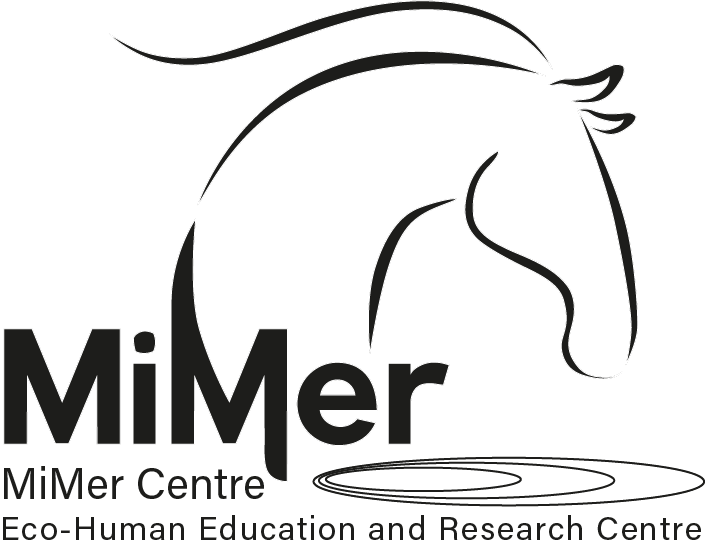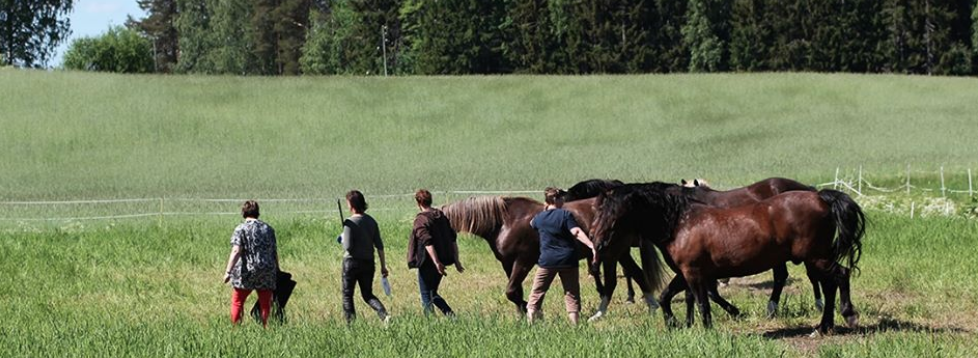Or – it goes more in a spiral movement – it is a circular and forward movement at the same time. We have a "novelty center" (the substantia nigra/ventral tegmental area or SN/VTA) in the brainstem connected to the hippocampus (memory) and the amygdala (emotion), all three located in our midbrains. Activation by seeking behavior/motivation to explore releases dopamine in the novelty center. Dopamine makes us feel good and is connected to learning (Horsehead.info).
If our horses live in an environment where they meet novel objects, people, situations, problems that are of a suitable challenge to them, they will learn. This is how all living beings evolutionary are designed – to learn and adapt to the environment we live in. A total lack, or too small challenges – will lead to boredom and apathy and no welfare, too big challenges (or even trauma), will overwhelm an individual's system and will not lead to any learning and will not contribute to welfare either.
For an individual to thrive – he needs appropriate challenges. To gain functional and useful knowledge of his environment – he specifically needs to learn about that. And what is the most prevalent "thing" in our horses' lives, which is the "thing" that is also most challenging to him? Humans. Horses need to learn about humans and all that we are about and do, hopefully with them and not so much to them (our behaviors, ideas, activities, environments).
In meeting new people, who behave in new ways, maybe go out for walks and explore new situations, horses get this in EAP/EATT.
This is how we, in any equine-assisted activity, can contribute with positive equine psychological welfare (and hence physiological – since they are connected) (Lundgren, 2018). "Animals need challenges to overcome because they provide animals with the chance to express agency and to gain functional competence through such work" (Bekoff & Pierce, 2017). Agency can be defined as "the propensity of an animal to engage actively with the environment with the main purpose of gathering knowledge and enhancing its skill for future use" and as the "intrinsic tendency of animals to behave actively beyond the degree of momentary needs, and to widen the range of competencies (Bekoff & Pierce, 2017).
Many horses live boring, isolated lives. This is a fact we seldom want to discuss. Most people neither have the finances nor the time, willingness and interest to change that.
"In simple, restrictive environments, animals cannot play, explore, or work at the levels they need to have a good life. Little or nothing is novel or interesting. They have reduced behavioral diversity. Behavior patterns become less versatile, often falling into stereotypies. Animals will sleep away their days, not because they are content, but because they are bored. Boredom, depression, and helplessness lead to heightened fear and anxiety, and a reduced ability to cope. Animals in impoverished environments heal more slowly, and so are likely to experience more prolonged periods of pain. […] If animals are to be kept in captivity, we must seek to provide them the freedom to exert control over their quality of life, and freedom from boredom." (Bekoff & Pierce, 2017)
For me – looking at my experiences of the equine-assisted activities I have been involved in (EAP, EAL, EATT, EAM) – this is exactly what these kinds of sessions can offer horses. Learning = Exploration. Novelty. Experience. Reward. Relaxation.
But. I want to add this. This is NOT the goal of EAP (and all other letter combinations). The goal is not to provide learning opportunities for horses. EAP is a treatment modality for humans, a psychological service to the people we call "clients". For the person(s) in the client role.
Why am I stressing that? How can I stress that and at the same time claim that EAP does not ever get any better than your equine welfare is? (and your level of equine welfare will be scrutinized by your clients, even if they do it unconsciously, even if they do not say anything about it – they will go by it to determine what you can offer them, how congruent, authentic and trustworthy you are).
The horse is not in the center of EAP, the client is. So the goal is not for him to learn anything. But he will. If it is good EAP, if there is an EP (Equine Professional) who looks out for his welfare, so it does not get negatively compromised (the horse needs to experience freedom from pain, hunger, thirst, sickness, etc) in (and outside) sessions. Because it is inherent in him to learn. It is for all of us – if we are not put in constant negative stress and experience constant overwhelming situations. What the EAP sessions provide for the horse – is this opportunity for learning. It is not removable. We do not have to strive for it. But we do need to strive for it outside sessions…. To maintain a high level of equine welfare.
We are all learning animals. It takes a lot for us to stop learning. And a curious, receptive, explorative, socially interested, motivated, etc – horse – is an asset in EAP. Because many clients have never had the opportunity to develop this seeking system, it has been way too overshadowed by their fear system. Or they have lost the ability due to life experiences, like trauma.
Everyone in any psychological balance learns. We get input from our senses, we seek that, that is part of the novelty-seeking. Horses to that too. They seek information through smell, sound, touch, sight, taste + via senses we don't have (Jacobson's organ e.g.). We learn even when learning is not on the agenda. If we were more aware of that – we would see how much horses learn from us (or our children…) – in all kinds of situations – without us intending to teach them anything. If a horse is not totally "shut-down" in a state of utterly learned helplessness, he will learn. Period. So if we stay aware of this constant learning-cycle that is there also for horses – we can use that knowledge too in therapy.
I want to point out again – if I am being unclear. It is not the EP's job to see that horses learn anything in EAP sessions, these sessions are not for the horse(s). But it will happen. They will learn. Let us use what is there. And let us explore this learning as part of his positive welfare, which adds something to his life.
Since any kind of meetings between beings is an intersubjective experience – and as such – they are changing everyone involved. Even if that is not the goal. That just happens. That is neuroplasticity. In therapy, this is used in a conscious manner, methodically, for the benefit of the client. So the client is the one who will learn the most, because that is the purpose of the treatment, for the client to be able to explore himself, learn about himself, change himself. The therapist puts all his/her energy into this change process, not into the horse's learning, not the EP's, not into his/her own – not during client sessions. A client session is client time. This is the service provided by the therapist. The horse(s) and the EP is there to support the client's process. The horse does it by just being himself, the more unconditioned he is, the abler he will be to be himself – A horse-individual. The EP is there to support the horse to be the horse he is – to look out for him, using her/his knowledge of horses and horse-human interaction to do that, and to be a safe, reliable person for the horse. (Because the EP will then see and understand what the horse needs in the situation, not fill that in with own wishes and projections of what he/she wants the horse to be and "give"). The more an EP knows about horses and horse-human interaction, the better he/she can do that job. The EP is also there to support the therapist with that knowledge. So the therapist can use what goes on with the horse, between horses, between humans and horses, between the horse and everything in the environment, which comes out as "behaviors", actions, physical and or mental "movement" which all can be called communication or language. This is part of the frame, the concept of EAP.
Much about horses is different from us. These differences we also use in EAP. Horses become a point of reference in many ways. They are similar enough to us to help clients project, attach, connect, identify, etc with/to them, but different enough for clients to separate out themselves (or other humans) from what the horses are and do. Processes, emotions, behaviors get enlarged, easier to see – they are done, communicated by the whole horse, his whole body. It gets easier for the therapist to reach deeper, see clearer what goes on, etc. There are many, many advantages to work with horses in therapy, this note is not about that. But as a conclusion, the differences play a part, so do the similarities.
"The problem isn't "imposing… a distinctly human understanding of the world". The problem is imposing a distinctly human misunderstanding. Our deepest insight into the living world: all life is one. Their cells are our cells, their body is our body, their skeleton is our skeleton, their hearts, lungs, blood, ours. If we impose that distinctly human understanding, we've taken one giant stride in seeing, truly each species within the vast living venture. Each is a distinction on a continuum, like notes on a violin's fingerboard. Therefore the finding. Fretless. No abrupt breaks. And quite a symphony" (Safina, 2015).
We are all learning animals. And we all need learning opportunities to thrive. That EAP can be that for horses – as a side effect, not a goal, is in my eyes – marvelous and needs to be acknowledged as a part of EAP, because even if it is not something that is intended, it is a result. And it can be used. Not the horse. The horse is never to be used, but what he is, is. Exactly as the therapist is never to be used, but what he/she knows, is. And as what the EP knows, can be used to. And to finish the comparison. As what the client knows about her/himself – is also what is used. His/her expertise on him/herself. To be him/herself.
I will keep on saying that we need to know about species-specific similarities and differences, as we need to know about individual similarities and differences. It is in this interplay between similarities and differences that we get to see ourselves, as well as others. As distinct subjects, individuals, but as a part of a whole. As an inner experience of ourselves – and as an outer experience of our role in relationships, our place in the world.
References:
Bekoff, M. & Pierce, J. (2017). The animals' agenda. Freedom, compassion, and coexistence in the human age. Beacon Press.
Lundgren, K. (2018). Freedom From... and Freedom To... Equine Welfare and the Role of the Equine Professional in Equine Assisted Interventions. In A Horse is a Horse, of Course. Compendium 2018. Ed. by Ilka Parent. Kindle Direct Publishing
Panksepp, J. & Biven, L. (2012). The Archeology of Mind. Neuroevolutionary Origins of Human Emotions. WW. Norton & Company
Peters, S., Butcher, M. & Skinner, A. Horsehead.info. https://horsehead.info/novelty-key-to-horses-and-riders/retrived 20190912
Safina, C. (2015). Beyond Words. What Animals Think and Feel. Henry Holt and Company.
Text and pictures are copyright protected. ©Katarina Felicia Lundgren, MiMer, 2019.



Comments